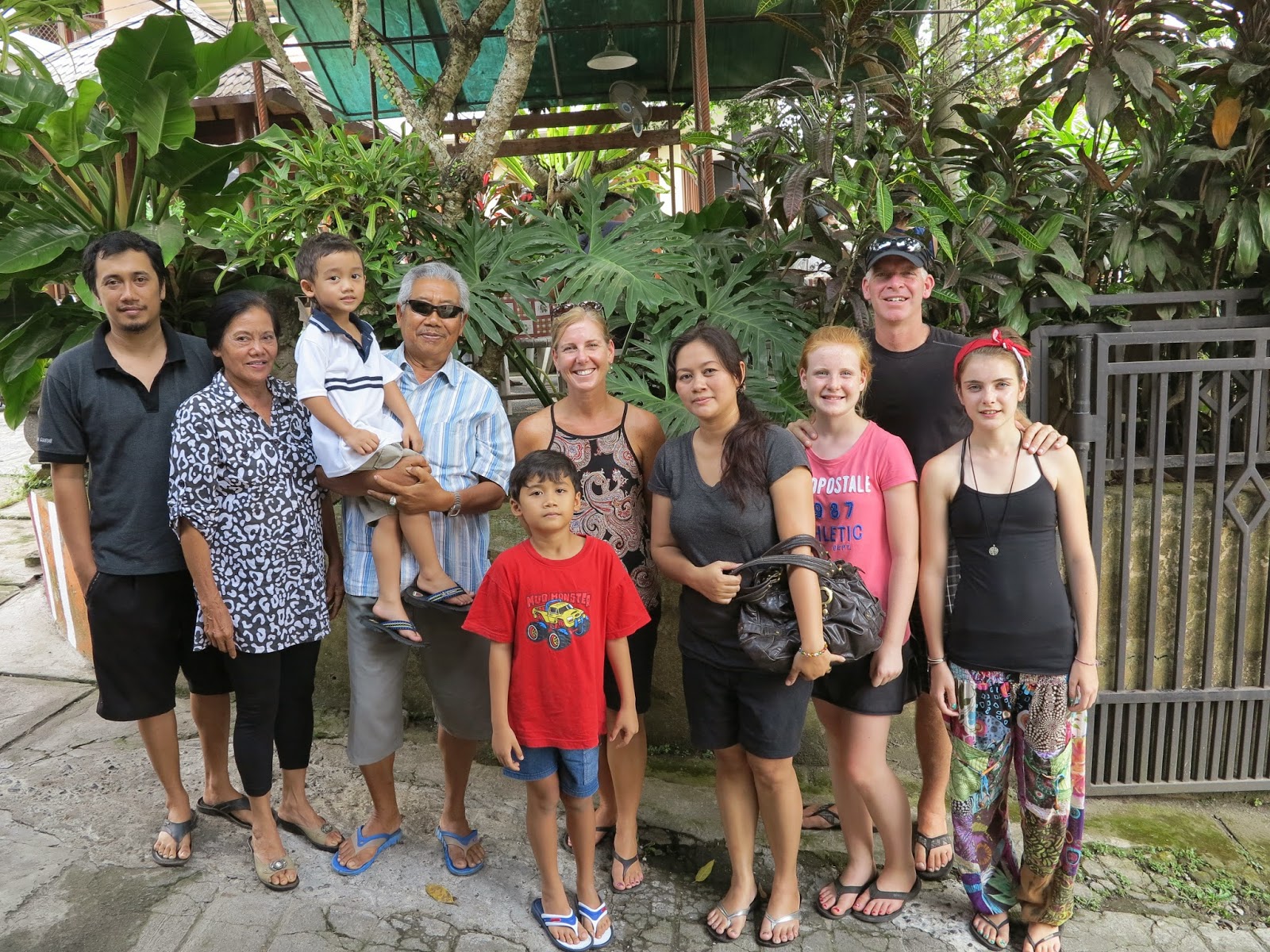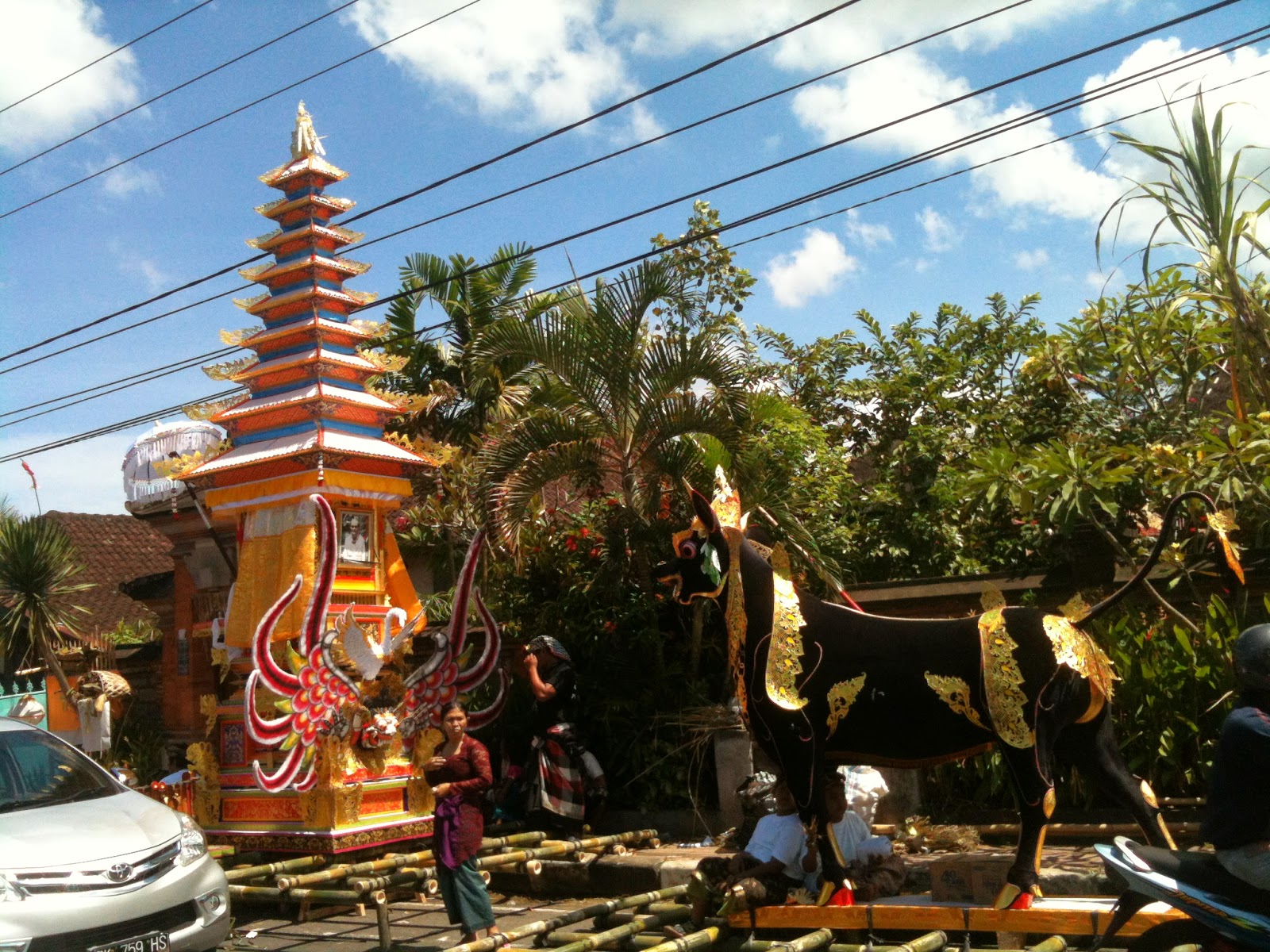The Balinese people believe in ruwa bineda; it means that every situation has two sides. This was another of Aji's lessons on Balinese culture. For
example, when a baby is born, the family is happy and joyous, yet the baby might
be crying. On the other hand, when a person dies, they may
die at peace, happy, after living a long and fulfilling life, yet the family may be devastated and grieving. There are always two
sides in every situation.
We experienced ruwa bineda first hand during our time in Ubud. The day that inspired this post, happened to be a good day in Bali. Good days and “not so good” days are dictated
by the Balinese calendar, called the Wuku. The Balinese calendar has 30 weeks
of 7 days, each with it’s own meaning. It is a complex calendar and Aji spent
30 minutes explaining the basic facts to Mark. Perfect understanding and interpretation of the
calendar is left to the priests. Being a good day, made it appropriate for a
cremation ceremony. When a Balinese person of Hindu descent dies, the body must
be cremated. Sometimes the family must
wait until they have saved enough money for the ceremony, so the body may be 'temporarily' buried. The burial could occur for a short period of time, or in some cases,
years. The ideal is to be cremated as close to the date of death as possible;
however, it must occur on a 'good' day. Today there were three cremation
ceremonies at the community temple and it happened to be Ally’s birthday; today
was a good day indeed! We were invited
to attend Aji’s aunt’s celebration, and we
were a little skeptical at first. Attending
a cremation on a birthday would not likely be considered a desirable learning
experience at home, but we considered it an amazing opportunity. Ally’s 14th birthday turned out to
be a birthday that she would never forget!
After our morning yoga and breakfast with our Families on
the Move Facebook group, we rushed home late (somethings don't change) to dress for the cremation
ceremony. It is a good thing that Bali operates on jam
karet, which translates into “rubber time”! We were required to wear traditional
Balinese clothing. Ibu, (Aji’s wife) outfitted us for the celebration. We
wore sarongs on the bottom and a kabaya on top, which is similar to a long
fitted blouse, often made of lace. Tied
at the waist was a sash. Men wear a
regular shirt and sarong, but a second sarong called a saput is layered on top
and is slightly shorter than the first.
Men also wear a hat which is called an udeng. After we were outfitted, we headed off to the home of the
deceased.
 |
| All dressed in our temple clothing! |
Aji’s aunt had passed away ten days prior and her cremation
was very quick in terms of Balinese culture.
In this case the body of the deceased remained at the family home until
the day of cremation, and there was no need for a temporary burial. Following the blessings, she was paraded through the
streets in a tower called a bede.
The
family lead the tower through town to the temple, and members of the community carried the bede and followed
along.
The tower often represents the
financial well being of the family and in
Aji’s aunt’s case, the tower was quite ornate and very tall.
So tall that men had to push up the hydro
wires with long bamboo poles to allow the tower to pass through the streets.
Mark cringed as the tower leaned, at risk of toppling over completely, not to mention
that it made contact with the wires several times.
The walk to the temple was similar to a
parade with live music and a brisk pace.
Considering
there were three live people riding on the tower, the deceased, and the weight
of the platform alone, the porter’s urgency was understood. Once the tower
arrived at the temple, the deceased’s body was removed from the coffin and placed
inside a decorative bull statue, called a lambu.
Tradition calls for the eldest daughter to sweep out the inside of the lamb with her hair, and prepare it for her mother’s body.
Once complete, the body was then covered with
sarongs, other items of clothing, and offerings which had been given as last
gifts to the departed.
Finally, the
lambu was set on fire with the crowds watching.
As you can imagine, the cremation process takes a while and all but the family move
back to their homes.
This was when we
made our quiet exit as well, and left Aji to remain with his family.
To complete the ceremony, the ashes would later
be collected and formed into the shape of a body.
The priest would bless the ashes along with offerings given from family members and the community. Finally, the ashes
would be scattered in the ocean. It was quite a spectacle to behold.
 |
| Transferring the body from the bede to the lambu |
Although people were in mourning, the event was quite
celebratory. Tears may have been shed, but
they were not shown in public. Never would you let your tears fall on the
deceased as this is believed to be bad luck
and create bad karma. I have loved
learning about the Bali-Hindu culture and traditions, where karma is held in high
regard. As Aji explained to us, one
strives to become one with God, which is quite difficult. You must always be aware of karma. He explained that if you are walking along and you step on an ant, it is considered to
be bad karma. It is believed that if you
‘do good’ during your life you will be reincarnated into a person and have
another chance to become one with God. If you ‘do bad’ you will be reincarnated
into an animal, which is not considered a desirable reincarnation. You must always try to ‘do good’. Becoming one with god is the ultimate goal
and is called Moksa.
 |
| The tower on a lean, trying to pass under the hydro wires. |
 |
It was quite a celebration with a professional photographer capturing every moment. It
reminded me more of a wedding rather than a funeral. Everyone was taking photos and video with their smartphones. |
 |
| You can see all of the layers of sarongs, and the lid of the bull is placed back on top. |
 |
| The community all leaves with the exception of family which has also moved a little further away due to the heat. |
 |
This was the third cremation procession that we saw. As you can see the tower is
still very ornate, but much smaller than the previous. It certainly made travelling through the
streets with the hydro wires much easier. |
As is the case with ruwa bineda, there is always two sides.
Despite having just attended a cremation ceremony to celebrate a death, we had a 14th birthday
to celebrate! Luckily for Ally, it was a good day!
As it goes with Canadian birthdays, Ally had a
few requests.
She asked for a jar of
peanut butter, Nutella and toast, to relax and read in the afternoon, and to
have pizza for dinner.
An interesting selection
of items, but a perfectly sensible order for a teenager on the road, I’m sure!
So, after picking up some birthday treats,
that was exactly what she got!
It was
certainly a birthday to remember and a
good great day in Bali!
 |
| Some of the items a 14 year old traveller requests on her birthday |
 |
| A Tree of Life pendant for our daughter who is full of life. |
 |
| Pizza dinner! |
 |
Mark met this amazing artist while out on a walk, and he agreed to give Ally some lessons.
She was thrilled with this birthday experience! |
 |
She was to choose the subject and decided to paint a photograph that we took
while in South Africa, on safari in the Addo Elephant park. |
























































